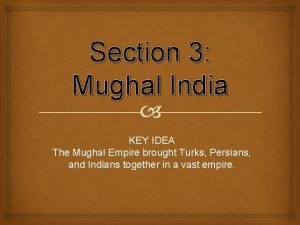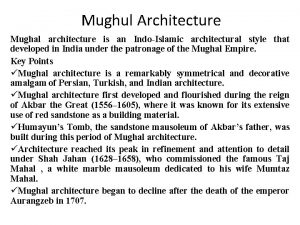Mughul Architecture Mughal architecture is an IndoIslamic architectural



- Slides: 3

Mughul Architecture Mughal architecture is an Indo-Islamic architectural style that developed in India under the patronage of the Mughal Empire. Key Points üMughal architecture is a remarkably symmetrical and decorative amalgam of Persian, Turkish, and Indian architecture. üMughal architecture first developed and flourished during the reign of Akbar the Great (1556– 1605), where it was known for its extensive use of red sandstone as a building material. üHumayun’s Tomb, the sandstone mausoleum of Akbar’s father, was built during this period of Mughal architecture. üArchitecture reached its peak in refinement and attention to detail under Shah Jahan (1628– 1658), who commissioned the famous Taj Mahal , a white marble mausoleum dedicated to his wife Mumtaz Mahal. üMughal architecture began to decline after the death of the emperor Aurangzeb in 1707.

• Tomb of Humayun v Mughal architecture under Akbar is the tomb of his father Humayun, situated in Delhi. v Commissioned in 1562 by Humayun’s wife, Hamida Banu Begum, and designed by a Persian architect v Humayun’s Tomb was the first garden tomb on the Indian subcontinent and the first structure to use red sandstone on such a large scale. v It is also the first Indian building to use the Persian double dome , with an outer layer supporting a white marble exterior—a material not seen in earlier Mughal architecture—and the inner layer giving shape to the cavernous interior volume. v The use of indigenous Rajasthani decorative elements is particularly striking, including the small canopies or chhatris (elevated, dome shaped pavilions) surrounding the central dome. v It boasts the use of the pietra dura technique, with marble and even stone inlay ornamentation in geometrical and arabesque patterns on the facade of the mausoleum, and jali or latticed stone carving decoration. v This style of decorative facade was an important addition to Mughal architecture and flourished in later Mughal mausolea, including the Taj Mahal.






